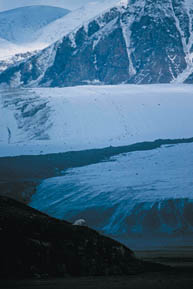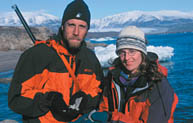Extreme Research (Page 2)


A polar bear tracks Larsson's team; Larsson with Natalia Rybczynski, showing some fossils they recovered.
The expedition succeeded in collecting bits of the feet and teeth of a tyrannosaur, which Larsson believes is the northernmost such finding. An important question that he is now investigating deals with whether this great carnivore actually ranged into northern climes or whether these remains ended up there as a function of a geological transfer.
Pressed into offering a preliminary guess, he says, "Migration. This would be a significant determination because so far tyrannosaurus has only been known over a fairly limited range: North and South Dakota, southern Alberta and Saskatchewan, and Montana."
Next summer Larsson and his team will venture another thousand kilometres further north, to Axel Heiberg Island, where they will utilize a McGill research station at Expedition Fjord for six weeks.
Making use of helicopter support, they'll be in a position to cover substantial territory. Thematically, this journey represents a continuation of the work undertaken on Bylot in that its yield will be entered into a growing database to chart community change among the creatures that once inhabited the Arctic. Funding for the project will come from the Natural Sciences and Engineering Research Council of Canada and the federal government's Canada Research Chairs program, under which Larsson holds a chair in Vertebrate Paleontology.
Vanishing History
Larsson laments how little we truly know about the distant past. "The fossil record is incredibly poor," he says. "There are only about 950 established species of dinosaurs, whereas today, in Africa alone, we could easily count up many, many more species of mammals. Considering that dinosaurs lived over the course of 150 million years, you can extrapolate, realistically, the vast numbers of species we should be finding."
To put things in perspective, he guesses that we have probably filled in only .2 of 1% of the natural history of the planet. Moreover, at best, he anticipates that enough evidence has been preserved for us ever to learn only 2% to 3% of the complete record. Only a paltry amount of physical evidence has survived the centuries.
"Even after we've theoretically exhausted all the fossils there are to be found, we still won't have an especially good grasp of what was once alive," he concludes. "The exact process of evolution will forever be lost to us."
Nonetheless, incredible discoveries are still being unearthed. Over the past decade, Larsson has made four field trips to Niger, because that country contains one of the earth's most fertile landscapes for fossilization. During a 1997 expedition, the so-called SuperCroc - Sarcosuchus imperator, or "flesh crocodile emperor" - was found at Gadoufaoua, as revealed in a paper published in the journal Science in October 2001 that Larsson co-authored along with expedition leader Paul Sereno, the University of Chicago professor with whom he undertook his graduate studies, Christian Sidor of the New York College of Osteopathic Medicine, and Boubé Gado of the Institut de Recherches en Sciences Humaines in Niamey, Niger. This imposing, voracious beast lived 110 million years ago and grew as long as 12 metres, weighing up to eight metric tons. At the size of a bus, with six-foot jaws lined with deadly incisor teeth, there are indications the colossal croc ate dinosaurs for breakfast.


